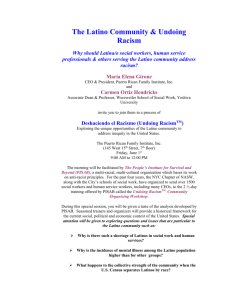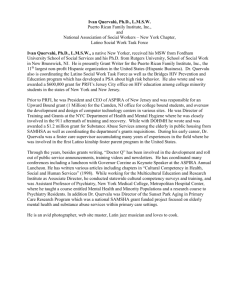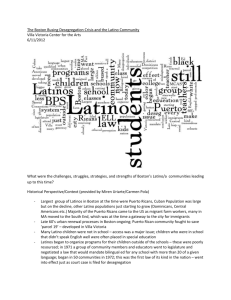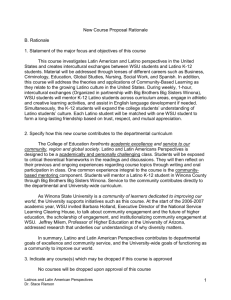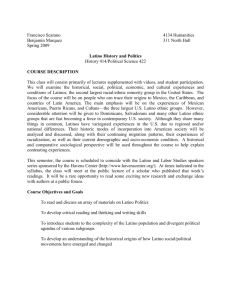Empire, Nations, and Migration: History of Latino/as in the United
advertisement
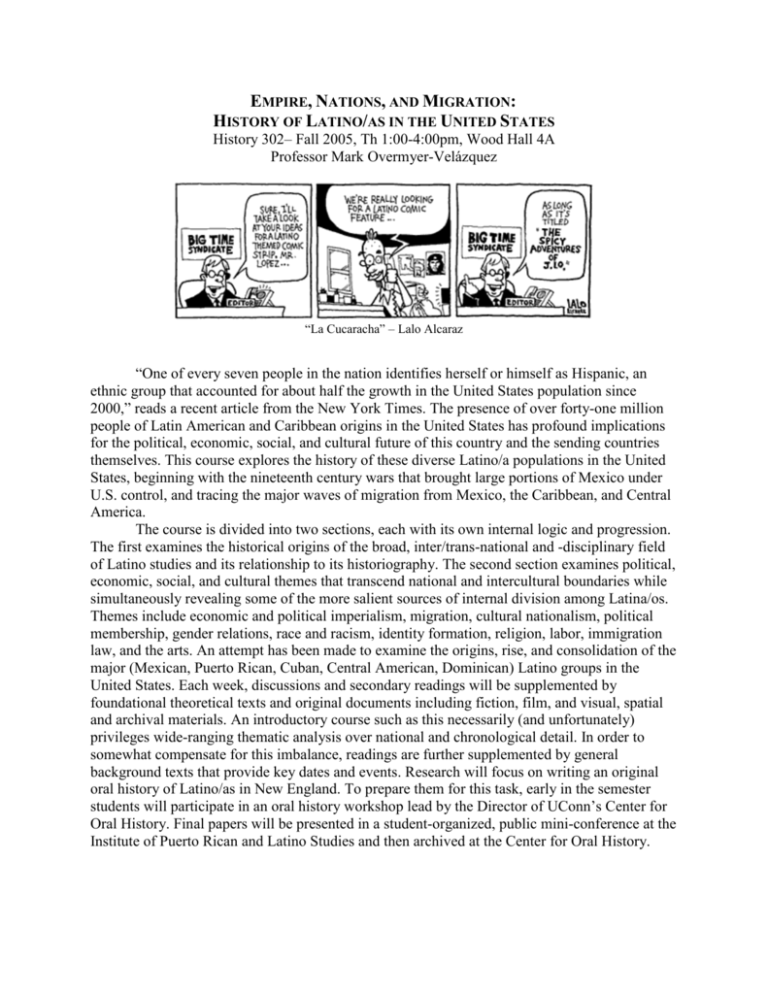
EMPIRE, NATIONS, AND MIGRATION: HISTORY OF LATINO/AS IN THE UNITED STATES History 302– Fall 2005, Th 1:00-4:00pm, Wood Hall 4A Professor Mark Overmyer-Velázquez “La Cucaracha” – Lalo Alcaraz “One of every seven people in the nation identifies herself or himself as Hispanic, an ethnic group that accounted for about half the growth in the United States population since 2000,” reads a recent article from the New York Times. The presence of over forty-one million people of Latin American and Caribbean origins in the United States has profound implications for the political, economic, social, and cultural future of this country and the sending countries themselves. This course explores the history of these diverse Latino/a populations in the United States, beginning with the nineteenth century wars that brought large portions of Mexico under U.S. control, and tracing the major waves of migration from Mexico, the Caribbean, and Central America. The course is divided into two sections, each with its own internal logic and progression. The first examines the historical origins of the broad, inter/trans-national and -disciplinary field of Latino studies and its relationship to its historiography. The second section examines political, economic, social, and cultural themes that transcend national and intercultural boundaries while simultaneously revealing some of the more salient sources of internal division among Latina/os. Themes include economic and political imperialism, migration, cultural nationalism, political membership, gender relations, race and racism, identity formation, religion, labor, immigration law, and the arts. An attempt has been made to examine the origins, rise, and consolidation of the major (Mexican, Puerto Rican, Cuban, Central American, Dominican) Latino groups in the United States. Each week, discussions and secondary readings will be supplemented by foundational theoretical texts and original documents including fiction, film, and visual, spatial and archival materials. An introductory course such as this necessarily (and unfortunately) privileges wide-ranging thematic analysis over national and chronological detail. In order to somewhat compensate for this imbalance, readings are further supplemented by general background texts that provide key dates and events. Research will focus on writing an original oral history of Latino/as in New England. To prepare them for this task, early in the semester students will participate in an oral history workshop lead by the Director of UConn’s Center for Oral History. Final papers will be presented in a student-organized, public mini-conference at the Institute of Puerto Rican and Latino Studies and then archived at the Center for Oral History. Seminar Requirements Attend and come prepared to all classes; Participate in discussions; (Co-) lead one/two week’s discussion; Research, write, and present an oral history paper Participation and presentation Following the first week of class, students (individuals or in groups) will prepare engaging and lively discussions and debates integrating the day’s readings and selected documents (examples include: census records, oral histories, physical spaces, films, poetry, archival and government records, feminist essays, and student selections). Students will consult with the instructor prior to their presentations. A short, provisional list of suggested (not required) readings accompanies each week’s readings to help those interested pursue specific themes in their own research. Consistent and thoughtful participation will determine a substantial part of your final grade. If discussion comes readily to you, look for ways to encourage others to participate. Absence from class precludes participation and has, therefore, an adverse effect on your grade. If you do miss a class meeting you will be responsible for finding out what was missed and for making up any assignments. Oral history project All students will have the opportunity to be involved in the production, presentation, and archiving of history. Students will contribute to the history of the Latino/a community in Connecticut by researching and writing the history of a Latino/a individual. The essay will place the histories of these individuals within the context of the major themes and issues of the course. Students will conduct an interview with a person of Latin American or Caribbean decent living in the region, write a 20-25 page biographic history paper (double spaced, 12 point font, with one-inch margins), and present the paper at a student-led oral history conference at the Institute of Puerto Rican and Latino Studies at UConn. Prior to conducting the interview we will discuss the methodology and practice of researching and writing an oral history. Students are expected to select their topics, in consultation with the instructor, and to submit a statement of their project no later than October 6th. Final Paper Due in class December 8th. All students will be responsible for and collaborate on the organization and publicity (targeted invitations and general media) of the conference. *Please do not submit assignments as email attachments. They must be turned in on paper. Participation Oral history project Conference presentation 30% 50% 20% 2 Readings Books are available for purchase at the UConn Coop. Individual articles and chapters are on Electronic Course Reserve [ECR] on the class WebCT. For those who read Spanish, there are also some (but not many) materials on the subject from Latin America itself; please see me in you are interested. David Gutiérrez, The Columbia History of Latinos in the United States Since 1960. New York: Columbia University Press, 2004. [CHL] Juan Poblete, ed., Critical Latin American and Latino Studies. Minneapolis: University of Minnesota Press, 2003. Donald A. Ritchie, Doing Oral History: A Practical Guide. New York: Oxford University Press, 2003. Dianne Walta Hart, Undocumented in L.A. An Immigrant’s Story. Wilmington: SR Books, 1997. Gilbert Joseph, et al. eds, Close Encounters of Empire: Writing the Cultural History of US – Latin American Relations. Durham: Duke University Press, 1998. Ruth Glasser, Aquí Me Quedo: Puerto Ricans in Connecticut. Hartford: Connecticut Humanities Council, 1997. George J. Sánchez, Becoming Mexican American: Ethnicity, Culture, and Identity in Chicano Los Angeles, 1900-1945. New York: Oxford University Press, 1993. Roger Daniels, Guarding the Golden Door: American Immigration Policy and Immigrants since 1882. New York: Hill and Wang, 2004. Thomas A. Tweed, Our Lady of the Exile: Diasporic Religion at a Cuban Catholic Shrine in Miami. New York: Oxford University Press 1997. Richard Rodriguez, Brown: The Last Discovery of America. New York: Penguin Books, 2002. Sarah Deutsch, No Separate Refugee: Culture, Class, and Gender on an Anglo-Hispanic Frontier, 1880-1940. New York: Oxford University Press, 1987. Peggy Levitt, The Transnational Villagers. Berkeley: University of California Press, 2001. Arlene Dávila, Latinos, Inc.: The Marketing and Making of a People. Berkeley: University of California Press, 2001. Selected articles and chapters [CP] 3 Internet Sites The following constitutes a limited list of reliable internet sites relevant to the course. Latin American Network Information Center (LANIC) http://www.lanic.utexas.edu/ Latin American Resources http://www.oberlin.edu/~svolk/latinam.htm The Latino History Project http://www.latinohistory.com Contact Information Office: Wood Hall 234 (860) 486-5571 mark.velazquez@uconn.edu Office Hours: Tuesdays 2-5pm and by appointment 4 COURSE SCHEDULE AND READINGS (Primary class day readings in bold) PART ONE: ORIGINS AND INTRODUCTIONS Week 1 – Sept. 1 INTRODUCTION: COURSE DETAILS Reading: David Gutiérrez, “Preface” and “Introduction” [CHL] Documents: 2000 U.S. Census Reports “Overview of Race and Hispanic Origin”: http://www.census.gov/prod/2001pubs/c2kbr01-1.pdf “The Hispanic Population: Census Brief”: http://www.census.gov/prod/2001pubs/c2kbr01-3.pdf “The Hispanic Population: 2000”: http://www.census.gov/prod/2001pubs/mso01-hp.pdf “We the People: Hispanics in the United States”: http://www.census.gov/prod/2004pubs/censr-18.pdf “Connecticut: 2000”: http://www.census.gov/prod/2002pubs/c2kprof00-ct.pdf “Race and Hispanic Origin of the Population by Nativity: 1850 to 1990”: http://www.census.gov/population/www/documentation/twps0029/tab08.html Film: “It’s Your Call with Lynn Doyle: Closing Borders” Suggested Readings: Juan González, Harvest of Empire: A History of Latinos in America. New York: Viking, 2000. Ilán Stavans, The Hispanic Condition: The Power of a People. New York: Rayo, 2001. Week 2 – Sept. 8 WHAT IS A LATINO/A?: PROBLEMS IN STUDYING U.S. LATINO HISTORY Readings: Juan Poblete, Critical Latin American and Latino Studies Lynn Stephen, et al., “Introduction: Understanding the Américas: Insights from Latina/o and Latin American Studies” in Perspectives on Las Américas [CP] “Editorial” and “Moving from the Margins to Where? Three Decades of Latino/a Studies” in Latino Studies Vol. 1 No. 1 [CP] Nicholas Dirks, et al. eds, Culture/Power/History: A Reader in Contemporary Social Theory, “Introduction.” Princeton: Princeton University Press, 1994. [CP] Documents: University of Connecticut Undergraduate Course Catalog: http://www.catalog.uconn.edu/second.htm University of Connecticut Graduate Course Catalog: http://catalog.grad.uconn.edu/ University of Connecticut Academic Spaces: Institute of Puerto Rican and Latino Studies: http://web.uconn.edu/prls/ 5 Center for Latin American and Caribbean Studies: http://clacs.uconn.edu/ Puerto Rican/Latin American Cultural Center: http://www.latino.uconn.edu/index.php Institute for African American Studies: http://www.iaas.uconn.edu/ Suggested Readings: Thomas Skidmore, “Studying the History of Latin America: A Case of Hemispheric Convergence” Latin American Research Review Vol. 33 No. 1. Alex Saragoza, “Recent Chicano Historiography: An Interpretive Essay” Aztlan Vol. 19 No. 1. Pedro Cabán and Frances Aparicio, “The Latino in Latin American Studies.” LASA Forum. Latin American Studies Association. Vol. XXXIII, No. 4. Pedro Cabán, “Puerto Rican Studies: New Challenges and Patterns.” Centro de Estudios Puertorriqueños Newsletter Fall 1985. Arthur Corwin, “Mexican Emigration History, 1900-1970: Literature and Research.” Latin American Research Review, Vol. 8, No. 2. D.J. Fernández, ed., Cuban Studies since the Revolution. Gainesville: University of Florida Press, 1992. Week 3 – Sept. 15 DOING HISTORY: ORAL HISTORY WORKSHOP *Class meets in the Administrative Conference Room at the Dodd Center. Workshop led by Professor Bruce Stave, Director of UConn’s Center for Oral History (http://www.ucc.uconn.edu/~cohadm01/) and Betsy Pittman, University Archivist. Readings: Donald A. Ritchie, Doing Oral History. Chapters 1, 3, 4, pp.75-83, and Appendices 1 and 2. Dianne Walta Hart, Undocumented in L.A.: An Immigrant's Story Oral History Methodology, Selected Handouts (in class) Norma Stoltz Chincilla, “Central American Immigrants: Diverse Populations, Changing Communities.” [CHL] Documents: University of Connecticut’s Oral History Collection Suggested Readings: Mario T. Garcia, Memories of Chicano History: The Life and Narrative of Bert Corona Cecilia Menjívar, Fragmented Lives: Salvadoran Immigrant Networks in America. Terry Repak, Waiting on Washington: Central American Workers in the Nation’s Capital Sarah J. Mahler, “Suburban Transnational Migrants: Long Island’s Salvadorans,” in Héctor Cordero-Guzmán, Robert C. Smith and Ramón Grosfoguel, eds. Migration, Transnationalization and Race in a Changing New York, Philadelphia: Temple University Press, 1999, 109- 130. Sarah J. Mahler, American Dreaming: Immigrant Life on the Margins. Princeton: Princeton University Press, 1995. Film: El Norte 6 Week 4 – Sept. 22 BECOMING LATINO/A: THE POLITICS OF IDENTITY Readings: George J. Sánchez, Becoming Mexican American Suzanne Oboler, Ethnic Labels, Latino Lives: Identity and the Politics of (Re)Presentation in the United States. Introduction and Chaps 1-3. [CP] David G. Gutiérrez, “Globalization, Labor Migration, and the Demographic Revolution: Ethnic Mexicans in the Late Twentieth Century.” [CHL] Documents: Student Selection: Texts for Examining the Historical Formation of Latina/o Identity Film: Culture Clash: “A Bowl of Beings: Revolutionary Comedy about Life, Death, and Pizza” Suggested Readings: Mary Romero, et al., eds, Challenging Fronteras: Structuring Latina and Latino Lives in the U.S. New York: Routledge, 1997. Benedict Anderson, Imagined Communities: Reflections on the Origin and Spread of Nationalism. New York: Verso, 1996. Richard Delgado, ed., The Latino Condition: A Critical Reader.. New York: New York University Press, 1998. David G. Gutiérrez, ed. Between Two Worlds: Mexican Immigrants in the United States. Wilmington: Scholarly Resources, 1996. Moisés González Navarro, Los extranjeros en México y los Mexicanos en el extranjero: 18211970. 3 vols. Mexico City: El Colegio de México, 1993. Rodolfo Acuña, Occupied America: A History of Chicanos. Editions One (1972) – Five (2003). Marcelo M. Suárez-Orozco, Crossings: Mexican Immigration in Interdisciplinary Perspectives. Cambridge: Harvard University Press, 1998. Film: Chicano!: History of the Mexican American Civil Rights Movement Week 5 – Sept. 29 NO CLASS MEETING Work on Oral History Projects; Prospectus due next week. PART TWO: CENTRAL THEMES AND COMPARISONS Week 6 – Oct. 6 LOCAL HISTORY/PUBLIC HISTORY: LATINOS IN CONNECTICUT *Additional Class Meeting this week: Dr. Eileen Findlay, Gender and History Series on Oct. 3/4. *Today’s class led by Professor Ruth Glasser 7 Readings: Ruth Glasser, Aqui Me Quedo Ruth Glasser, “Waterbury, Connecticut: An Evolving Multi-Latino City” [CP] Jorge Klor de Alva, “Aztlán, Borinquen, and Hispanic Nationalism in the United States.” [CP] Kelvin Santiago-Valles, “Social Polarization and Colonized Labor: Puerto Ricans in the United States, 1945-2000.” [CHL] Documents: Nuestras Historias/Our Histories – Connecticut Historical Society Oral History Project: http://www.chs.org/nuestrashistorias/main.htm Suggested Readings: Sources for the Study of Puerto Rican Migration, 1879-1930. History Task Force. Centro de Estudios Puertorriqueños. New York: CUNY, 1982. th Ronald Fernandez, The Disenchanted Island: Puerto Rico and the United States in the 20 Century. José Cruz, Identity and Power: Puerto Rican Politics and the Challenge of Ethnicity. Philadelphia: Temple University Press, 1998. Alfredo López, Puerto Rican Papers: Notes on the Re-Emergence of a Nation. James Dietz, Economic History of Puerto Rico: Institutional Change and Capitalist Development. Carmen T. Whalen, From Puerto Rico to Philadelphia. Puerto Rican Workers and Postwar Economies. Philadelphia: Temple University Press, 2001. Virginia Sanchez-Korrol, From colonia to community: The History of Puerto Ricans in New York City, 1917-1948. Berkeley: University of California Press, 1994. Film: Puerto Rican Passages **Due in class: Oral History Paper Prospectus** Week 7 – Oct. 13 THE OTHER SIDE OF THE COIN: U.S. EMPIRE AND HISTORY FROM “BELOW” Readings: Gilbert Joseph, et al. eds, Close Encounters of Empire (Chaps. by Joseph, Findlay, LeGrand, Fein, Derby, and Suescun Pozas) Gonzalez and Fernandez, A Century of Chicano History: Empire, Nations, and Migration. Chaps. 2 and 3. [CP] Mary Louise Pratt, Imperial Eyes: Travel Writing and Transculturation. “Introduction.” [CP] Documents: Texts from the History of Latin American – U.S. Relations. [CP] Suggested Readings: Helen Delpar, The Enormous Vogue of Things Mexican: Cultural Relations between the United States and Mexico, 1920-1935. Tuscaloosa: University of Alabama Press, 1992. 8 José E. Limón, American Encounters: Greater Mexico and the United States and the Erotics of Culture. Boston: Beacon Press, 1998. Fredrick B. Pike, The United States and Latin America: Myths and Stereotypes of Civilization and Nature. Amy Kaplan and Donald E. Pease, eds., Cultures of United States Imperialism Gyan Prakash, ed., After Colonialism: Imperial Histories and Postcolonial Displacements. Princeton: Princeton University Press, 1995. Andrés Resendez, “Guerra e identidad nacional,” Historia Mexicana (1997). Andres Reséndez, “National Identity and the Shifting U.S.- Mexico Border 1821-1848,” Journal of American History (86) (Sept1999). Week 8 – Oct. 20 GUARDING THE GOLDEN DOOR: IMMIGRATION, LABOR, AND THE LAW Readings: Roger Daniels, Guarding the Golden Door Robert Asher and Charles Stephenson, “American Capitalism, Labor Organization, and the Racial/Ethnic Factor: An Exploration.” In Asher and Stephenson, eds., Labor Divided: Race and Ethnicity in United States Labor Struggles, 1835-1960. Albany: State University of New York Press, 1990, 3-27. [CP] Kevin R. Johnson, “The Continuing Latino Quest for Full Membership and Equal Citizenship.” [CHL] Documents: Homer Library Search: Author = United States. Immigration and Naturalization Service. Suggested Readings: Bill Ong Hing , Defining America Through Immigration Policy. Philadelphia: Temple University Press, 2004. Kevin R. Johnson, The Huddled Masses Myth: Immigration and Civil Rights. Philadelphia: Temple University Press, 2003. Antoinette Sedillo Lopez, Latino Employment, Labor Organizations and Immigration (Latinos in the United States, Vol 4). New York: Garland Publishing, 1995. Carey McWilliams, Factories in the Field: The Story of Migratory Farm Labor in California. New York: Archon Books, 1969. Nelson Lichtenstein, State of the Union: A Century of American Labor. Princeton: Princeton University Press, 2003. David Jacobson, The Immigration Reader: America in a Multidisciplinary Perspective. Oxford: Blackwell Publishers, 1998. 9 Week 9 – Oct. 27 RELIGION AND THE LATINO/A EXPERIENCE Readings: Thomas A. Tweed, Our Lady of the Exile María Cristina García, “Exiles, Immigrants, and Transnationals: The Cuban Communities of the United States.” [CHL] Anthony Stevens-Arroyo, “From Barrios to Barricades: Religion and Religiosity in Latino Life.” [CHL] Document: Poem: Rodolfo “Corky” Gonzales, “Yo Soy Joaquin (I Am Joaquin),” 1967 [CP] Film: I Am Joaquin, Teatro Campesino. Suggested Readings: Román de la Campa, Cuba on My Mind: Journeys to a Severed Nation. London: Verso, 2000. Boswell and Curtis, The Cuban-American Experience: Culture, Images, and Perspectives. María Garcia, Havana USA: Cuban Exiles and Cuban Americans in South Florida, 1959-1994. Ada Ferrer, “Rustic Men, Civilized Nation: Race, Culture, and Contention on the Eve of Cuban Independence,” HAHR 78(4) (Nov. 1998). Louis A. Perez, On Becoming Cuban: Identity, Nationality, and Culture. Chapel Hill: University of North Carolina Press, 1999. Anthony Stevens-Arroyo, ed., Enigmatic Powers: Syncretism with African and Indigenous Peoples’ Religions Among Latinos. Helen Rose Ebaugh, Religion and the New Immigrants. Film: Miami/Havana Week 10 – Nov. 3 GIVE IT THE SHADE: RACE AMONG LATINA/OS Readings: Richard Rodriguez, Brown Edward Said, Orientalism. Introduction [CP] Jeffrey O.G. Ogbar, “Rainbow Radicalism: The Rise of Radical Ethnic Nationalism” in Black Power: Radical Politics and African American Identity. Baltimore: The Johns Hopkins University Press, 2004. [CP] Jorge Klor de Alva, Earl Shorris, and Cornel West “Our Next Question: The Uneasiness between Blacks and Latinos.” [CP] Roberto P. Rodriguez-Morazzani, “Beyond the Rainbow: Mapping the Discourse on Puerto Ricans and “Race.” [CP] 10 Documents: United States National Archives II, General Records of the Department of State (RG 59), “Race Problems” [CP] Suggested Readings: Neil Foley, The White Scourge: Mexicans, Blacks, and Poor Whites in Texas Cotton Culture. Berkeley: University of California Press, 1998. David G. Gutiérrez, Walls and Mirrors: Mexican Americans, Mexican Immigrants, and the Politics of Ethnicity. Berkeley: University of California, 1995. Paul Gilroy, The Black Atlantic: Modernity and Double Consciousness. Cambridge: Harvard University Press, 1995. Clara E. Rodriguez, Changing Race: Latinos, the Census and the History of Ethnicity in the United States. New York University Press, 2000. Ivan Hannaford, Race: The History of an Idea in the West. Baltimore: The Johns Hopkins University Press, 1996. Nicholas De Genova and Ana Y. Ramos-Zayas, Latino Crossings: Mexicans, Puerto Ricans, and the Politics of Race and Citizenship. New York: Routledge, 2003. Week 11 – Nov. 10 GENDER AND CLASS ENCOUNTERS Readings: Sarah Deutsch, No Separate Refugee Pierrette Hondagneu-Sotelo, “Gender and the Latino Experience in Late-Twentieth-Century America.” [CHL] Documents: Selections from, Chicana Feminist Thought: The Basic Historical Writings [CP] Suggested Readings: Gloria Anzaldúa, Borderlands/La Frontera: The New Mestiza. San Francisco: Spinsters/Aunt Lute, 1987. Gloria Anzaldúa and Cherríe Moraga, This Bridge Called My Back: Writings by Radical Women of Color. Susana Chávez-Silverman, “Tropicolada: Inside the U.S. Latino/a Gender B(l)ender.” In Frances R. Aparicio, ed., Tropicalizations: Transcultural Representations of Latinidad. Deena González, Refusing the Favor: Spanish-Mexican Women of Santa Fe, 1820-1880. New York: Oxford University Press, 1999. Pierrette Hondagneu-Sotelo, ed., Gender and U.S. Immigration: Contemporary Trends Vicki Ruíz, Cannery Women/Cannery Lives: Mexican Women, Unionization and the California Food Industry, 1930-1950. Albuquerque: University of New Mexico Press, 1987. Julia Alvarez, How the García Girls Lost their Accents. Lionel Cantu, “Border Crossings: Mexican Men and the Sexuality of Migration.” Ph.D. Dissertation, University of California, Irvine, 1999. O.M. Espin, Women Crossing Boundaries: A Psychology of Immigration and Transformation of Sexuality. New York: Routledge, 1999. 11 O.M. Espin, Latina Realities: Essays on Healing, Migration, and Sexuality. Colorado: Westview Press, 1997. Eithne Luibheid, Entry Denied: Controlling Sexuality at the Border. Minneapolis: University of Minnesota Press, 2002. Week 12 – Nov. 17 EL OTRO LADO/THE OTHER SIDE: BORDERS AND OTHER TRANSNATIONAL CONDITIONS Readings: Peggy Levitt, The Transnational Villagers Peggy Levitt, “Transnational Ties and Incorporation.” [CHL] Walter D. Mignolo, Local Histories/Global Designs: Coloniality, Subaltern Knowledges, and Border Thinking. Princeton, NJ: Princeton University Press, 2000. Selections. [CP] José David Saldívar, Border Matters: Remapping American Cultural Studies. Berkeley: University of California Press, 1997. Selections. [CP] Documents: Student Selection: Texts for Examining the “Border” (E.g.: Gómez-Peña, Coco Fusco, Gloria Anzaldúa, Corridos (http://www-mcnair.berkeley.edu/2000journal/Hernandez/Hernandez.html), North American Free Trade Agreement (NAFTA), Minuteman Project (http://www.minutemanhq.com/), Lalo Alcaraz, etc.) The William Benton Museum of Art, Exhibits: Roadmaps and Colonial Power by Enrique Chagoya and LA Chicanas and the Border by Jaoquin Trujillo. Suggested Readings: Mario T. García, Desert Immigrants: The Mexicans of El Paso, 1880-1920. New Haven: Yale University Press, 1981. Mario T. García, “La Frontera: The Border as Symbol and Reality in Mexican-American Thought” in David G. Gutiérrez ed. Between Two Worlds: Mexican Immigrants in the United States. Wilmington: Scholarly Resources, 1996, 89-117. Guillermo Gómez-Peña, The New World Border: Prophecies, Poems, and Loqueras for the End of the Century. San Francisco: City Lights, 1996. John Mason Hart, ed. Border Crossings: Mexican and Mexican-American Workers. Wilmington: Scholarly Resources, 1998. Oscar J. Martínez, Border People: Life and Society in the U.S. – Mexico Borderlands. Tucson: University of Arizona Press, 1994. Frank Bonilla, et. al. eds., Borderless Borders: U.S. Latinos, Latin Americans, and the Paradox of Interdependence. Philadelphia: Temple University Press, 1998. Rubén Martínez, The Other Side: Notes from the New L.A., Mexico City, and Beyond. New York: Vintage, 1992. Miguel Tinker Salas, “Sonora: The Making of a Border Society, 1880-1910.” Journal of the Southwest, vol. 34, no. 4, 429-456. Gloria Anzaldúa, Borderlands/La Frontera: The New Mestiza. 2nd Ed. San Francisco: Spinsters/Aunt Lute, 1999. Timothy Dunn, The Militarization of the U.S.-Mexico Border, 1978-1992: Low-Intensity Conflict Doctrine Comes Home. Austin, TX: CMAS Books, University of Texas Press, 1996. 12 Patricia R. Pessar, A Visa for a Dream: Dominicans in the United States. Boston: Allyn and Bacon, 1995. Gabriel García Márquez, The Autumn of the Patriarch. Week 13 – Nov. 24 NO CLASS MEETING: THANKSGIVING BREAK Week 14 – Dec. 1 HOW MUCH FOR YOUR LATINO?: COMMODIFYING ETHNCITY *Class meets at Hartford’s Pan-Latino Coffee House and Bookstore, La Paloma Sabanera For directions/information: http://www.lapalomasabanera.com/ Readings: Arlene Dávila, Latinos, Inc. Frances Aparicio, “U.S. Latino Expressive Cultures.” [CHL] Musical Selections. Document: Pan-Latino Space: La Paloma Sabanera Coffee House and Bookstore Identidad Latina, Hispanic Newspaper – Hartford, CT http://www.identidadlatina.com/ Suggested Readings: Clara Rodríguez, Latin Looks: Images of Latinas and Latinos in the U.S. Media. Boulder: Westview Press, 1998. Geoffrey Fox , Hispanic Nation: Culture, Politics, and the Construction of Identity. Tucson: University of Arizona Press, 1996. Edward James Olmos, et al. eds, Americanos: Latino Life in the United States. Boston: Little, Brown and Company, 1999. Alfred Schreibner, Multicultural Marketing:Selling to the New America. New York: McGraw Hill, 2000. Lousi E. V. Nevaer, The Rise of the Hispanic Market in the United States: Challenges, Dilemmas, and Opportunities for Corporate Management. New York: M.E. Sharpe, 2004. Francisco Valle, How to Win the Hispanic Gold Rush: Critical Cultural, Demographic, Marketing, and Motivational Factors. New York: iUniverse, 2003. Week 15 – Dec. 8 ORAL HISTORY CONFERENCE: INSTITUTE OF PUERTO RICAN AND LATINO STUDIES **Due in class: Oral History Paper** 13 14
